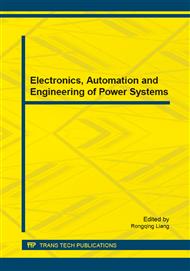[1]
Z. S. Yao, Research on theories and methods of short-term traffic flow forecasting of road network based on real-time data, Beijing, Beijing Jiaotong University, 2007. In Chinese.
Google Scholar
[2]
G. G. He, Y. Li, S.F. Ma: Systems Engineering Theory & Practice, Vol. 12(2000), pp.51-56. In Chinese.
Google Scholar
[3]
M. C. Tan, S. C. Wong, J. M. Xu, Z. R. Guan, and P. Zhang: IEEE Transactions on Intelligent Transportation Systems, Vol. 10, No. 1(2009)., pp.60-69.
Google Scholar
[4]
W. Shen, X. P. Guo, C. Wu, D. S. Wu: Knowledge-based Systems, Vol. 24, No. 3(2011), pp.378-385.
Google Scholar
[5]
A. L. Ding, X. M. Zhao, L. C. Jiao: The IEEE 5th International Conference on Intelligent Transportation Systems, pp.727-730(2002).
Google Scholar
[6]
Manoel Castro-Neto, Young-Seon Jeong, Myong-Kee Jeong, Lee D. Han: Export Systems with Application, Vol. 36(2009), pp.6164-6173.
Google Scholar
[7]
D. Wang, B. Jiang: Journal of System Simulation, Vol. 19, No. 6(2007), pp.1177-1181.
Google Scholar
[8]
K. Tang, G. S. Hu, X. L. Che, L. Hu: Journal of Jilin University (Science Edition), Vol. 48, No. 2(2010), pp.251-255. In Chinese.
Google Scholar
[9]
Li Ming-Wei, Hong Wei-Chiang, Kang Hai-Gui: NEUROCOMPUTING, Vol. 99(2013), pp.230-240.
Google Scholar
[10]
D. S. Gong, J. X. Che, J. Z. Wang, J. Z. Liang: Second International Symposium on Intelligent Information Technology Application, pp.85-89(2008).
Google Scholar
[11]
X. L. Li, A new intelligent optimization method -artificial fish school algorithm, Zhejiang, Institute of Systems Engineering of Zhejiang University, 2003. In Chinese.
Google Scholar
[12]
Y. Ye, L. C. Gu, S. W. Li: 3rd International Conference on Information Computing and Applications, (2012).
Google Scholar
[13]
M. Y. Jiang, D. F. Yuan, Artificial fish swarm algorithm and its application, Science Press, Beijing (2012).
Google Scholar
[14]
Danial Yazdani, Adel Nadjaran Toosi, Mohammad Reza Meybodi, AI 2010: Advances in Artificial Intelligence, Vol. 6464(2011), pp.334-343.
DOI: 10.1007/978-3-642-17432-2_34
Google Scholar
[15]
Freeway Performance Measurement System (PEMS), Information on http: /pems. dot. ca. gov.
Google Scholar
[16]
Young-Seon Jeong, Young-Ji Byon, Manoel Mendonca Castro-Neto, and Said M. Easa: IEEE Transactions on Intelligent Transportation Systems, Vol. 14, No. 4(2013).
Google Scholar
[17]
Hong Wei-Chiang: Neural Computing & Application, Vol. 21, No. 3(2012), pp.583-593.
Google Scholar
[18]
Chih-Chung Chang, Chih-Jen Lin, LIBSVM: A Library for Support Vector Machines[CP/OL], ACM transactions on intelligent systems and technology, Vol. 2, No. 27(2011), pp.1-27.
DOI: 10.1145/1961189.1961199
Google Scholar


